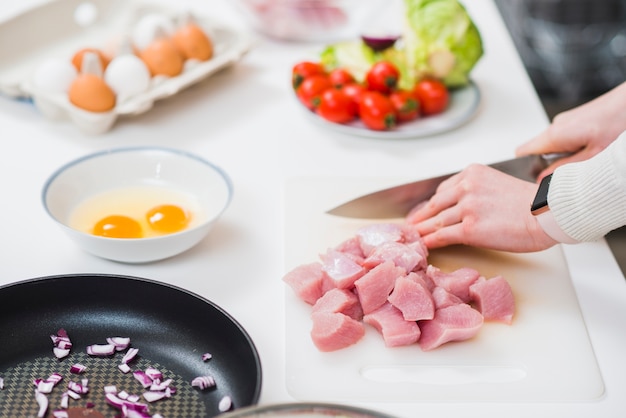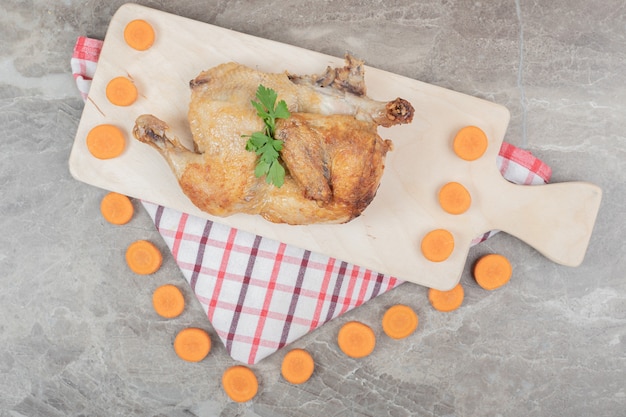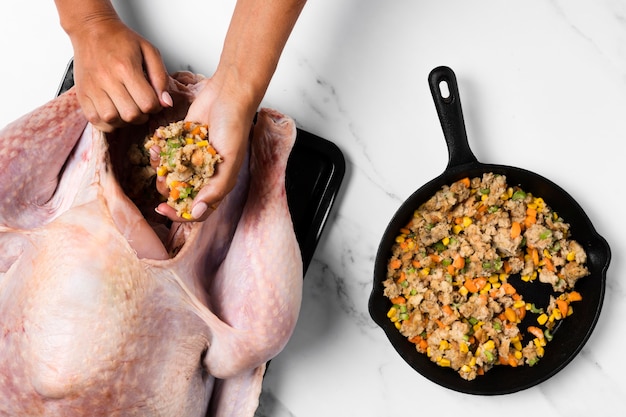Let's talk chicken thighs, everyone's favourite versatile and flavourful cut! They're budget-friendly, oh-so-tasty, and have this magical ability to stay juicy even when cooked well-done. But, how long do you actually cook them for to achieve that juicy, tender, and perfectly cooked result? That's the question we're tackling today, my friends.
My journey with chicken thighs hasn't always been smooth sailing. Back in my early cooking days, I was all too familiar with dry, overcooked thighs. Nobody wants that, right? So, I embarked on a quest for knowledge, experimenting, reading countless cookbooks, and watching countless cooking shows – all in the name of perfect chicken thighs!
Today, I'm sharing everything I've learned with you, along with some of my personal favourite recipes. We'll be covering oven roasting, pan-frying, and even some grilling techniques. Grab your apron, gather your favourite spices, and let's dive in!
(Part 1) Understanding the Basics: Factors That Influence cooking time

Before we jump into specific cooking times, let's lay down some fundamental principles that determine how long your chicken thighs need to cook. Think of it like a puzzle where each piece plays a crucial role:
1. Size Matters: The Big and the Small
Chicken thighs come in all shapes and sizes, and the bigger they are, the longer they'll take to cook through. A small, dainty thigh might be done in 20 minutes, while a large, hefty one could need 30 minutes or more.
2. Thickness Makes a Difference: The Skinny vs. the Chunky
Just like a steak, thicker chicken thighs need a little extra time to cook through. Think of it as a heat-conducting challenge. The thicker the meat, the longer it takes for the heat to reach the center and cook it thoroughly.
3. Cooking Method: From Gentle Roasting to Fast Frying
Different cooking methods require different cooking times. Oven roasting, for example, tends to be a gentler, slower process, taking longer than pan-frying, which utilizes a higher heat and shorter cooking time.
4. Temperature Control: Hot or Mild, It Makes a Difference
The temperature of your oven or stovetop plays a significant role in cooking time. A hotter oven or stovetop means faster cooking, while a lower temperature requires more time.
5. Bone-In or Boneless: A Matter of Heat Retention
Bone-in chicken thighs generally require a bit more cooking time compared to boneless thighs. This is because the bone retains heat, slowing down the cooking process of the surrounding meat.
Keep these factors in mind as we delve into the specifics of each cooking method and how to master them for perfect chicken thighs.
(Part 2) Oven Roasting: A Gentle Path to Tenderness and Juiciness

Oven roasting is the classic way to cook chicken thighs, and for good reason. It produces exceptionally tender and juicy results, and it's a great method for cooking a larger batch of thighs. Here's how I do it:
1. Preheat for Perfection: Setting the Stage for Success
Start by preheating your oven to 180°C (350°F). This temperature ensures even and consistent cooking, leading to perfectly cooked chicken thighs.
2. Prepare Your Thighs: A Seasoning Symphony
Pat your chicken thighs dry with kitchen paper. Season them generously with salt, pepper, and any other herbs or spices you love. My personal favourite is a blend of paprika, garlic powder, and onion powder, which adds a touch of warmth and depth.
3. A roasting pan and Room to Breathe: Creating an Ideal Cooking Environment
Place your seasoned chicken thighs in a roasting pan, making sure they have enough space to cook evenly. Don't overcrowd the pan. You can also add some vegetables like chopped onions, carrots, or potatoes to the pan, creating a complete one-pan meal that's both delicious and convenient.
4. Roast to Perfection: The Art of Patience
Roast your chicken thighs for about 30-40 minutes, or until they reach an internal temperature of 74°C (165°F). You can check the temperature with a meat thermometer, a trusty tool for ensuring your chicken is cooked to perfection. A good visual indicator is to check if the juices run clear when you pierce them with a fork.
5. Rest for Rejuvenation: A Final Touch for Tenderness
Once your chicken thighs are cooked through, remove them from the oven and let them rest for 5-10 minutes before serving. This allows the juices to redistribute, resulting in even more tender and juicy chicken.
Oven roasting is a fantastic way to cook a batch of chicken thighs, offering convenience and a delicious result. It's also great for creating one-pan meals by adding vegetables to the pan for a complete and satisfying dish.
(Part 3) Pan-Frying: crispy skin and Intense Flavour

Pan-frying is for those who adore the irresistible combination of crispy, golden-brown skin and juicy meat. It's a quick and easy method for smaller batches of chicken thighs. Here's how to make it happen:
1. Heat Your Pan: Creating a Sizzling Surface
Heat a heavy-bottomed pan over medium-high heat. Heavy-bottomed pans distribute heat evenly, ensuring consistent cooking results. Add a tablespoon or two of oil to the pan, and let it heat up properly before adding your chicken thighs.
2. Prepare Your Thighs: A Flavorful Foundation
Pat your chicken thighs dry with kitchen paper. Season them generously with salt, pepper, and any other herbs or spices you fancy. A pinch of smoked paprika adds a delicious smoky depth to your chicken thighs.
3. Sear for Crispy Perfection: A Key to Deliciousness
Carefully place your chicken thighs in the hot pan, skin-side down. Let them cook undisturbed for 4-5 minutes, or until the skin is wonderfully crispy. You should hear a delightful sizzle as the fat renders out, creating a symphony of deliciousness.
4. Flip and Finish: Ensuring Even Cooking
Once the skin is golden and crispy, flip the chicken thighs and cook them for another 4-5 minutes, or until they're cooked through. Check the temperature with a meat thermometer to make sure they've reached 74°C (165°F).
5. Rest for Reinvention: A Final Touch of Juiciness
Remove your chicken thighs from the pan and let them rest for a few minutes before serving. This allows the juices to redistribute, ensuring a more tender and flavorful result.
Pan-frying is a quick and easy method for cooking a smaller batch of chicken thighs. It's perfect for a busy weeknight meal or a quick and delicious lunch.
(Part 4) Grilling: Smoky Flavour and Delightful Grill Marks
grilling chicken thighs adds an irresistible smoky flavour and those beautiful grill marks that make them look so enticing. Here's how to grill your way to deliciousness:
1. Preheat Your Grill: Setting the Stage for a Smoky Feast
Preheat your grill to medium-high heat. If you're using a gas grill, make sure the flames are nice and even for consistent cooking.
2. Prepare Your Thighs: A Seasoning Symphony for the Grill
Pat your chicken thighs dry with kitchen paper. Season them generously with salt, pepper, and any other herbs or spices you love. A blend of garlic powder, onion powder, and smoked paprika adds a lovely smoky flavour to your grilled chicken thighs.
3. Grill to Perfection: A Journey of Smoky Flavour
Place your chicken thighs on the hot grill, making sure they have enough space to cook evenly. Grill them for about 5-6 minutes per side, or until they're cooked through. Check the temperature with a meat thermometer to ensure they've reached 74°C (165°F).
4. Rest for Reinvention: A Final Touch of Juiciness
Remove your chicken thighs from the grill and let them rest for a few minutes before serving. This allows the juices to redistribute, creating more tender and juicy chicken.
Grilling is a fantastic option for outdoor cooking and perfect for enjoying the warm weather. You can also grill other vegetables alongside your chicken thighs, like peppers, onions, or zucchini, for a complete and delicious grilled meal.
(Part 5) A Handy Guide: Cooking Times in a Table
To make things even clearer, here's a table summarising the average cooking times for bone-in chicken thighs using different cooking methods:
| Cooking Method | Cooking Time | Internal Temperature |
|---|---|---|
| Oven Roasting (180°C/350°F) | 30-40 minutes | 74°C/165°F |
| Pan-Frying (Medium-High Heat) | 8-10 minutes total (4-5 minutes per side) | 74°C/165°F |
| Grilling (Medium-High Heat) | 10-12 minutes total (5-6 minutes per side) | 74°C/165°F |
Remember that these are general guidelines. You may need to adjust the cooking time based on the size and thickness of your chicken thighs, as well as the heat of your oven or grill.
(Part 6) Exploring Flavours: chicken thigh recipes for Every Tastebud
Now that we've covered the basics, let's explore some exciting flavour combinations that will elevate your chicken thighs to new heights of deliciousness.
1. Mediterranean Chicken Thighs: A Burst of Sunshine Flavours
This recipe is all about vibrant Mediterranean flavours:
- Season your chicken thighs with a mixture of dried oregano, thyme, garlic powder, and a pinch of red pepper flakes. The herbs add a beautiful aroma and flavour, while the red pepper flakes provide a subtle warmth.
- Drizzle them with olive oil and lemon juice. This adds a touch of acidity and richness, complementing the herbs and spices.
- Roast them in the oven until cooked through. The oven roasting method ensures tender and juicy chicken thighs.
- Serve them with a side of couscous or quinoa, and top with chopped fresh parsley and crumbled feta cheese. The couscous or quinoa provides a light and fluffy base, while the parsley adds freshness, and the feta cheese provides a salty and tangy counterpoint.
2. Spicy Asian Chicken Thighs: A Fusion of Flavour and Heat
This recipe packs a punch of flavour and heat, perfect for those who love a little spice:
- Mix together soy sauce, honey, ginger, garlic, and a dash of chili flakes to create a marinade. The soy sauce adds a salty and savory base, the honey provides sweetness, the ginger and garlic bring a fragrant and spicy kick, and the chili flakes add a touch of heat.
- Marinate your chicken thighs in the mixture for at least 30 minutes. This allows the flavours to infuse into the meat, creating a truly delicious result.
- Pan-fry them until crispy and cooked through. The pan-frying method creates a crispy skin and juicy meat.
- Serve with a side of steamed rice, and sprinkle with sesame seeds and chopped green onions. The steamed rice provides a neutral backdrop, the sesame seeds add a nutty flavour, and the green onions bring a fresh and vibrant touch.
3. Honey Garlic Chicken Thighs: A Symphony of Sweet and Savory
This recipe is sweet, savory, and incredibly flavourful, a perfect combination for any palate:
- Combine honey, soy sauce, garlic, and a pinch of black pepper to create a glaze. The honey provides sweetness, the soy sauce adds a salty and savory base, the garlic brings a pungent aroma, and the black pepper adds a touch of spice.
- Brush the glaze over your chicken thighs and grill them until cooked through. The grilling method adds a delicious smoky flavour and beautiful grill marks.
- Serve with a side of mashed potatoes or roasted vegetables. The mashed potatoes provide a creamy and comforting accompaniment, while the roasted vegetables offer a delightful medley of textures and flavours.
(Part 7) Top Tips for Chicken Thigh Perfection: Mastering the Craft
Here are some helpful tips to help you elevate your chicken thighs to a whole new level of deliciousness:
- Use a meat thermometer to ensure your chicken thighs are cooked through to a safe internal temperature of 74°C (165°F). A meat thermometer is your best friend when it comes to ensuring your chicken is perfectly cooked and safe to eat.
- Don't overcrowd your pan or roasting pan. If you're cooking multiple chicken thighs, make sure they have enough space to cook evenly. Overcrowding the pan can lead to uneven cooking and potentially steaming rather than browning the chicken thighs.
- Let your chicken thighs rest for a few minutes before serving. This allows the juices to redistribute, resulting in even more tender and juicy chicken. This simple step makes a significant difference in the overall tenderness and flavour of your chicken thighs.
- Don't overcook your chicken thighs. Overcooked chicken thighs will be dry and tough. Overcooking is the enemy of juicy and tender chicken thighs. It's better to err on the side of undercooked than overcooked.
- Experiment with different herbs and spices to find your favourite flavour combinations. There's a whole world of flavour combinations to explore, so don't be afraid to try new things and discover your own personal favourites.
- Don't be afraid to get creative. You can add vegetables to your roasting pan, or serve your chicken thighs with a variety of sauces or sides. Get creative and let your imagination run wild. There's no limit to what you can do with chicken thighs.
(Part 8) Frequently Asked Questions: Solving Your Chicken Thigh Dilemmas
Here are some frequently asked questions about cooking chicken thighs, to help you navigate any culinary challenges you might encounter:
1. Can I Cook Chicken Thighs From Frozen?
Yes, you can cook chicken thighs from frozen, but it's important to adjust the cooking time. Increase the cooking time by about 50% to ensure the chicken is cooked through. It's best to thaw them in the refrigerator overnight for the best results, as it allows the chicken to thaw slowly and evenly, preserving the quality of the meat.
2. How Do I Know If My Chicken Thighs Are Done?
The best way to tell if your chicken thighs are done is to use a meat thermometer. The internal temperature should reach 74°C (165°F). You can also check if the juices run clear when you pierce them with a fork. This is a visual cue, but it's always best to use a meat thermometer for accuracy.
3. Can I Reuse the Pan Drippings for a Sauce?
Yes, you can definitely reuse the pan drippings for a sauce. Just strain them through a fine-mesh sieve to remove any bits of chicken. You can then use them to make a delicious pan sauce by adding some butter, flour, and your favourite herbs and spices. The pan drippings are full of flavour, so don't throw them away!
4. What Should I Serve With Chicken Thighs?
Chicken thighs are incredibly versatile and can be served with a variety of sides. Some popular choices include mashed potatoes, roasted vegetables, rice, couscous, quinoa, and salads. You can also pair them with pasta, noodles, or even serve them in tacos or sandwiches for a fun twist.
5. Can I Substitute chicken breasts for Chicken Thighs in a Recipe?
You can substitute chicken breasts for chicken thighs in a recipe, but you'll need to adjust the cooking time. Chicken breasts cook much faster than chicken thighs. Make sure to check the internal temperature with a meat thermometer to ensure they're cooked through. Chicken breasts are more prone to drying out than chicken thighs, so be careful not to overcook them.
There you have it, folks – a comprehensive guide to cooking chicken thighs to perfection! From basic tips to flavour combinations and frequently asked questions, you're equipped to create delicious and satisfying meals with this versatile ingredient. Now go out there and experiment, have fun, and enjoy the juicy, flavorful goodness of perfectly cooked chicken thighs!
Everyone is watching

How to Cook Frozen Lobster Tails Perfectly: A Step-by-Step Guide
RecipesLobster. Just the word conjures up images of lavish meals, special occasions, and a taste of luxury. But let's...

Pigs in a Blanket Cooking Time: How Long to Bake for Perfect Results
RecipesAh, pigs in a blanket. Just the name conjures up images of those delightful little parcels of crispy pastry en...

Pork Fillet Cooking Time: How Long to Cook It Perfectly
RecipesPork fillet, or tenderloin as it's sometimes called, is a real favourite in our house. It's so versatile, and...

The Ultimate Guide to Cooking Delicious Frankfurters
RecipesLet's face it, we all love a good frankfurter. It's a classic, simple, and always satisfying. But let's be rea...

Wolf Meat Recipes: A Guide to Cooking Wild Game
RecipesLet's be honest, you don't see wolf meat at your local butcher shop every day. It's a bit of a wild card, but ...
